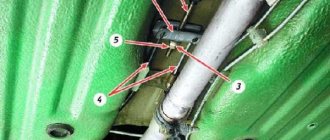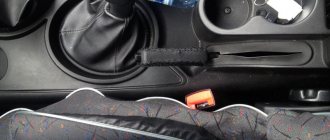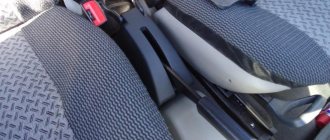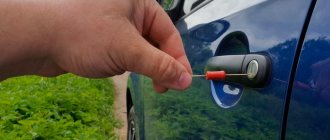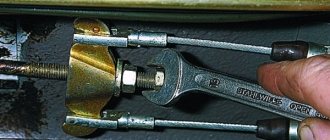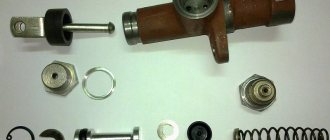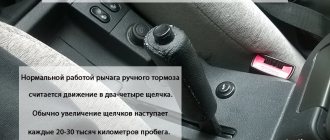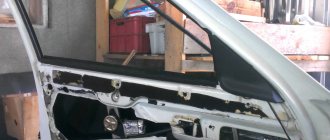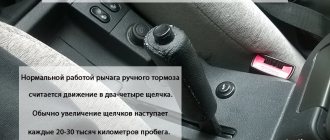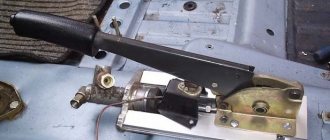- Design
- Tension
- Dismantling and replacement
The VAZ 2114 car has good performance, reliability and maintainability.
But this does not allow you to completely insure yourself against possible breakdowns. Considering the state of domestic roads, it is not surprising that most often car owners turn to service stations with problems in the braking system or suspension.
A striking example of a breakdown is problems with the handbrake. More precisely, with cables that are responsible for blocking the rear wheels and do not allow the car to move until the handbrake is returned to its original position.
Whether you use a handbrake or not, sooner or later you will need to use the system. And if the handbrake has to survive regularly, then there is no debate at all regarding the need to urgently solve the problem.
Design
Many people mistakenly believe that the handbrake is a simple lever located near the gearbox, on the right hand of the driver. In fact, it is a whole system of elements that are connected to each other.
When the hand brake fails, in 90% of cases the culprit is a cable or a pair of cables that go to the rear brake pads from the equalizer.
To determine the reasons for the failure of the handbrake, it is necessary to understand the circuit diagram of the device and its components.
The device includes a number of structural elements. Namely:
- Lever arm;
- Traction;
- Springs;
- Lever button;
- Main cable axis;
- Bolts;
- Washers;
- Drive unit;
- Equalizer;
- Case;
- Locknuts;
- Cotter pins;
- Right and left lever;
- Expansion left and right strip;
- Lock washer, etc.
Replacing the hand brake rod of a VAZ 2110
The parking brake linkage often requires replacement because it is used in conditions of high humidity and dirt. The most common reason for replacing it is a rusty thread, which makes it impossible to adjust the handbrake. To perform the work, you need to lift the car on a lift or drive it into a pit. Next, follow these steps:
- Lower the handbrake lever to the down position.
- Unscrew the adjusting and locking nuts from the lever rod.
- Remove the lever axis by pulling out the pin with pliers.
- Remove the lever rod from the cable equalizer housing.
Installation is in the reverse order. After installation, adjust the parking brake tension.
Thanks for subscribing!
Tension
So, having understood the diagram, you can begin the procedure of tightening the handbrake cables.
The tensioning procedure is as follows.
- Place the car on an overpass or pit. If you don’t have a garage and you have the opportunity or desire to carry out the procedure at a service station, use a jack. The rear of the car is raised on a jack. The most extreme option is a curb onto which the car is driven and all you have to do is crawl under it.
- Engage the gearbox in first gear and put the car on the handbrake by pulling the lever up.
- The ideal number of handbrake clicks is from 2 to 5. If there are fewer or more clicks, it is easier to take appropriate measures to tension the cable.
- If there are less than 2 clicks, then the cable will need to be lengthened. If there are more than five clicks, then the cables are shortened.
- Lengthening the cable means relaxing it. To do this, unscrew the locknut. When tightening the cable, the locknut must be tightened in reverse.
- Before you start looking for the required nut on the bottom of the car, release the handbrake lever all the way.
- Take a 13mm wrench under the car and head down.
- Find the handbrake cable equalizer. This is the same element from which the main handbrake cable is divided into two cables.
- In some cases, it is simply not possible to gain access to the equalizer, since the muffler holders made of rubber are in the way. In such a situation, it is better to remove them. This is not difficult to do, but working with the handbrake will be much easier.
- Now there are two nuts in front of you. One is a simple nut and the other is a lock nut. Having two keys in your hands, fix the nut with the first one, and with the second one begin to unscrew or tighten the locking nut. Be careful that the nut does not start to turn.
- Taking into account the condition of the handbrake and the need to loosen or tighten the lever, turn the locknut in the appropriate direction. Remember what is the optimal number of clicks.
- Tighten or unscrew the locknut to obtain the required degree of tension.
Examination
But if you twisted the nuts there, this is not a guarantee that the handbrake now works perfectly. This needs to be clearly verified.
To do this, it is enough to go through a successive stage of verification activities.
If the check shows that the handbrake still does not hold, even if the cable was tensioned exactly according to the instructions, the handbrake is probably simply worn out and the cable needs to be replaced.
Signs that replacement is needed
It is not uncommon for the VAZ 2114 handbrake cable to rust, as a result of which it breaks or weakens so much that no tightening can restore its previous functionality.
At the first sign of cable wear, you should consider replacing it. This problem may manifest itself as follows:
- The handbrake is not able to withstand the required traction;
- Drum brakes overheat;
- When you pull the parking brake lever, the cable does not respond to your actions;
- The cable sheath is seriously worn.
Signs that replacement is needed
It is not uncommon for the VAZ 2114 handbrake cable to rust, as a result of which it breaks or weakens so much that no tightening can restore its previous functionality.
At the first sign of cable wear, you should consider replacing it. This problem may manifest itself as follows:
- The handbrake is not able to withstand the required traction;
- Drum brakes overheat;
- When you pull the parking brake lever, the cable does not respond to your actions;
- The cable sheath is seriously worn.
To check the operation of the handbrake, it is enough to perform one simple action. Place the car on a level surface, apply the handbrake, get out of the car and try to push it hard. If movement begins, the cable is dead and needs urgent replacement.
Dismantling and replacement
It is difficult to confuse the cable from the handbrake with anything else under the bottom of your VAZ 2114, which greatly simplifies the repair and replacement procedure.
We provide detailed instructions for replacement, and additionally recommend watching the video.
- We advise you to get the car in order in terms of cleanliness in advance. This will make it easier for you to find all the nuts and fasteners.
- Additionally, treat the nuts with the almighty WD40. This will make it much easier for you to unscrew the sometimes sticking and rusting nuts.
- Place the handbrake lever all the way down.
- Start with the adjusting nut and locknut that you used recently to try to tighten a loose cable. In this situation, you should loosen the nuts and remove them from the handbrake rod.
- Remove the washers and cable equalizer. Although this can be done after you jack up the car. But be sure to do it before removing the wheels.
- Raise the rear of the car with a jack, unscrew the wheel bolts and remove them.
- Tap the brake drum locking pins. This will allow them to be removed from the brake pads.
- Remove the block.
- You now need to disconnect the ends of the two cables from the equalizer. The fasteners can be removed from their places with the simplest pliers, so don’t bother.
- The shifted spacer lever has hooks from which the cable loop can be removed.
- The cable sheath must be removed from the entire suspension of the rear of the car. To do this, the mounting bolts are first unscrewed.
- Pull the cable out of the holes through the brake flaps.
- We got rid of the old cable, so all that remains is to replace the old one with a new element. The procedure is performed exactly in reverse order.
- Thread the new cables through the washers and hook the loops. You can additionally make bosses - this is a special clamp that allows you to fix the cable even more tightly.
- Reassemble the entire disassembled wheel structure.
- Route the cable along the suspension through the sheath and secure the bolts.
- Pull the handbrake in the cabin.
- Check the correct tension and operation of the new hand brake, or rather the cable.
When is cable drive repair needed?
While operating the vehicle, it is important to determine the moment when replacing the handbrake cable becomes absolutely necessary. When stopped by a traffic police inspector, the defect is equated to a technical malfunction and is punishable by a fine. A simple check of the functionality of the handbrake is to park the car on a slope with the brake applied. If the car rolls, it's time to start repairing it.
The main symptoms of problems with the cable mechanism are as follows:
- Excessive heating of brake drums.
- Lack of response when tensioning the cable transmission.
- Worn cable sheath.
- The tension adjustment of the mechanism is broken.
If the last point can be solved with a simple adjustment, then other manifestations of the malfunction require drastic methods. In this case, you need to understand the reasons for the situation:
- cable breakage or stretching;
- moisture entering the shell, especially in winter;
- souring of the cable inside the sheath due to insufficient lubricant.
Sometimes you can do without replacing the cable or other elements of the handbrake - just restore the lubrication. Practice shows that such a procedure, carried out once a year, significantly increases the service life of parts.
Preparatory activities
replacing the cable Novice VAZ 2114 drivers usually do not risk starting to repair the cable unit on their own, preferring the services of auto repair shops, and, it must be said, in vain. Finding the handbrake drive under the bottom of the car is not difficult, and with minimal skills and a small set of tools, the issue will be resolved within 3-4 hours. For repair you will need:
- Overpass or inspection hole.
- Open-end wrench set to "10".
- Two keys for "13".
- Pliers.
- Plastic clamps.
- Large flathead screwdriver.
- WD-40 lubricant.
To make your work more comfortable, you should clean the bottom of the car from dirt and lubricate all threaded units with WD-40.
Why the handbrake does not work on the VAZ 2107
Like any other part or mechanism, the handbrake cable tends to wear out and become unusable. The parking brake on the VAZ 2107 is activated using a lever located in the middle part of the car between the driver and passenger seats.
We recommend: Grooving brake discs without removing: how to do it yourself
Periodically, the handbrake cable should be tightened, as it becomes weakened, which leads to a decrease in the efficiency of the device. The reasons why the handbrake on the “seven” may not function are due to the following factors:
- Excessive cable stretch.
- Damage to the cable.
- Malfunction of the brake mechanism in the rear wheel drums.
During prolonged use of the car, when the handbrake is constantly used, owners are faced with the need to periodically restore the cable tension. Over time, the device in question stretches, and there is nowhere to tighten it. The only way out of the situation is to exchange the product for a new one. It is recommended to carry out work on replacing the handbrake cable in an inspection hole, but you can do without it.
Changing the handbrake cable
Replacing the handbrake cable on a VAZ 2107 car begins with the fact that it is first necessary to dismantle the brake drums of the rear wheels. After dismantling the brake drums, you should pay attention to the condition of the rear brake pads and working cylinders. The presence of traces of fluid leakage will indicate that the mechanisms also need repair.
Each owner of his car decides individually when it is necessary to change the handbrake cable. It all depends on the degree of wear of the cable. The procedure for replacing the parking brake cable is divided into 2 stages: dismantling and installation, as well as adjusting the tension.
The replacement algorithm is as follows:
- After the rear wheels and brake drums are removed, you need to go down into the inspection hole and find the tension adjusting rod. This rod is equipped with a spring, which must be removed using a screwdriver.
- Both nuts are unscrewed, after which the adjustment bar is removed. Next, the rear and front handbrake cables are dismantled.
- Using a wrench, you need to unscrew the two nuts securing the two brackets. These brackets prevent the cable from falling. There are screws under the nuts that prevent them from unscrewing on their own.
- After this, you should remove the rear brake drums and remove the springs that secure the brake pads. The pads can also be replaced if they show excessive wear.
- Next, you need to pull the cable to disengage it from the bracket against which it rests.
- The brake pads are removed. There is no need to remove both pads on the wheel. To replace the rear cable, you only need to remove one rear brake pad.
- Now you should unscrew two fixing bolts from the back of the brake shield of both wheels. With their help, the cable tip is fixed. After unscrewing these two bolts, you should pull the cable, as shown in the photo below.
- Using a 10mm wrench, you need to unscrew the front cable mounting brackets. After unscrewing the bolt, carefully remove the roller. To remove the roller, you need to roll it forward in the direction of the tip.
- To remove the front part of the device, you need to pull on the product to remove it from the bracket and intermediate support structure.
- After this, you need to get out of the hole and go into the car interior. When performing work, the handbrake must be in its lowest position. Inside, unscrew the two screws securing the handle trim.
- There are 4 bolts under the cladding that need to be unscrewed. After unscrewing them, you will need to remove the handle along with the front cable.
- To disconnect the cable mount from the handle, you will need to use pliers to remove the small cotter pin that secures the device to the handbrake handle.
- After this, the device can be completely removed from the car and a new cable installed in its place. The installation process of both products is carried out in the reverse order of removal. After this, you should secure them and begin the tension adjustment procedure.
It is important to know! When installing the rear cable, it is important to know the following: this element has right and left sides. On the right side there is a rubber tube, which acts as additional insulation of the braid from the nearby hot resonator pipe.
Adjusting the hand brake VAZ 2107
Adjustment of the handbrake should be performed not only periodically when the parking brake is lost, but also after replacing the cable. In order to adjust the cable tension, you will need to take the following tools:
- pliers;
- two keys for 13;
- a can of WD-40 lubricant.
The procedure for replacing a faulty handbrake cable on a VAZ 2114
Having placed the car on an overpass or inspection hole, you need to release the handbrake lever all the way and secure the wheels with shoes. It won't hurt to dismantle the muffler can - this will make the work much easier. The process then proceeds as follows:
- Unscrew the adjusting and locking nut using keys “13” and remove them from the rod.
- Loosen the wheel bolts with a wheel wrench, jack up the rear of the car and remove the rear wheels.
- Using a hammer and a wooden extension or long bolts, remove the brake drums and knock out the locking pins.
- Remove the brake pads.
- Disconnect the cable ends from the equalizer and remove the clamps using pliers.
- Before replacing faulty handbrake cables, the loops of both cables must be removed from the spacer lever.
- After unscrewing the fastening bolt, remove the cable sheath from the rear suspension.
- Pull the cable mechanism out of the holes in the brake flaps.
- Install the new element in the reverse order, first pulling it through the washers and loops on the hooks of the lever.
If the device shell is damaged, it must be replaced. Since the design of the parking brake on the VAZ 2114 involves the use of two cables, regardless of their condition, both need to be changed.
It happens that fastening parts become corroded and are no longer suitable for further use. In this case, the use of plastic clamps as clamps is justified. All that remains is to check the functionality of the system by setting the car on an incline and tightening the handbrake. If it rolls, then you need to adjust the tension of the cable mechanism.
How to change the handbrake cable with your own hands
In a car, the hand brake, it would seem, does not play as important a role during operation as the foot brake. And in general, compared to other nodes, it doesn’t seem to matter much.
In the parking lot you can leave the car at speed. When starting down a hill, the foot brake will somehow help. Car enthusiasts often think this way if, for example, the linkage of a unit is broken, and they are too lazy to replace a broken handbrake cable. But the operation is not so complicated, we will prove it later. At the same time, cravings break due to banal situations:
- natural aging, gradual stretching with use, delamination of the unit;
- temperature changes in winter, leading to rupture under load;
- poor quality material of the part installed at the factory.
We begin repair work if there is an inspection hole.
- First, lower the assembly lever in the cabin.
- Next, at the bottom, loosen the adjusting nut, as well as the lock nut. Unscrew and remove these nuts.
- Having loosened the fastenings of the rear wheels, as well as placing stops under the front ones, we lift the rear part of the car with a jack. We remove the wheels.
- After removing the studs from the brake pads, we knock down the brake drums using a hammer and a wooden block.
- Next, having dismantled the brake pad and unscrewed the bolt on it, you can finally disconnect the end of the handbrake rod from it - each rod from each unit.
- At the rear of each brake unit, we pull out the cable drive in the shell, then remove the shell.
- This releases our treasured part; all that remains is to pull it out of all the fasteners under the body. Then you can install the new one in reverse order.
The handbrake cable on a VAZ 2109 is replaced in the same way. When changing the cable on a VAZ 2110, we also follow the instructions given, but at the same time you will have to unfasten the interfering muffler, or rather, its end part, and then lower it. Otherwise there are no changes.
To replace the handbrake cable on a Niva VAZ 2123, we follow the instructions given above, however, before releasing the rods from the wheel brake assemblies, you will have to unscrew the nuts securing the wheel guards.
The same applies to replacing a defective handbrake cable on a Gazelle. There, in the same way, you will have to unscrew two nuts in order to pull the rod removed from the pads out of the wheel guard.
True, on some modifications of the VAZ, the defective part is attached to the underbody using a threaded connection. Then you need to unscrew the nut. By the way, we must first treat all threaded connections with an aerosol-type penetrating lubricant.
What to do with the “manual” assembly of foreign cars
Now let’s discuss the procedure as applied to popular foreign cars. To replace the cable on a Mitsubishi Lancer 10 we will need:
- hammer, wooden block;
- wrenches, screwdrivers;
- wheel chocks;
- penetrating aerosol lubricant.
Also read about replacing the timing chain on an Opel Corse and replacing the license plate light bulb on a Nissan Qashqai. The peculiarity of this car is that part of the assembly, unlike the VAZ, runs inside the cabin. Therefore, the actions here are as follows.
- We unscrew the armrest fastenings, and then remove the armrest.
- We dismantle the rear seat - this is done easily. Then unscrew the handbrake linkage.
- Next, loosen the bolts of the rear wheels, install wheel chocks under the front wheels, and lift the rear of the car using a jack.
- Remove the rear wheels. While in the inspection hole, unscrew the fastening of the part on the rear beam.
- Remove the brake drums using a hammer and a piece of wood.
- We unfasten the brake pads, and then disconnect the ends of the treasured part from them.
- We pull the defective unit into the cabin and disconnect it from the parking system lever.
- We pull the new spare part through and fasten it in the reverse order.
Replacing a broken handbrake cable on a Hyundai Accent is done in much the same way. This car will also have to remove the rear seat.
Interestingly, the German Volkswagen Golf has a similar parking system design. However, to replace the handbrake cable, say, in a Golf 6, you do not need to remove the rear seat. The rods of the wheel mechanisms exit under the bottom through the muffler tunnel. After disconnecting from the equalizer, you just need to pull them down.
The handbrake cable of the Volkswagen Passat B4 is replaced in the same way, since the unit here is designed following the example of the Golf.
Now let’s look at how to replace the handbrake cable on a Nexia. For this procedure, we will take the following tools, as well as available means:
- hammer, wooden block;
- wrenches, screwdrivers;
- wheel chocks;
- penetrating lubricant "VD-40".
We begin work, as always, with an inspection hole.
- We unfasten the protective casing for the resonator and lower it down. You can secure it with ropes.
- The control unit opens to us. Unscrew the adjusting nut from it.
- We remove the defective rods going to the rear wheels from all the brackets on the bottom of the car.
- We install wheel chocks under the front of the car. Raise the rear and remove the rear wheels.
- After unscrewing the drum nuts, we tap these parts using a hammer and a wooden block.
- After removing the brake drums, the end of each rod is fished out from the brake shoe lever.
- We remove the retaining ring that secures the rod in the brake assembly.
- Pull the end of the wire out of the brake assembly.
- A new spare part is installed on both sides on the way back.
This is how the handbrake cable on a Daewoo Nexia is replaced. Isn't it a relatively simple operation?
Now let’s figure out how to replace the handbrake cable on a Ford Focus 2. To carry out the procedure, we will take the following tools and devices:
- hammer, block of wood;
- sets of keys, screwdrivers;
- pliers;
- wheel supports;
- penetrating lubricant.
We start again from the inspection hole.
- We unfasten and remove the parking system control lever from the interior.
- We detach the protective metal screen of the additional muffler from below.
- The equalizer, to which two wires are attached, is located under the bottom; we pull out the lower end of the cable drive from it.
- Using a screwdriver, pry up the seal of the hole inside the passenger compartment and pull out both the seal itself and the braided core.
- When updating, this part of the node is installed along the opposite path.
- To reinstall the braided wires going to the wheels, we proceed as follows. Inside the cabin, having removed the cover from the parking brake lever, we unscrew the lock nut, but we do not unscrew the adjusting nut all the way, thereby completely weakening the system.
- From below, from the inspection hole, we squeeze the clamps with pliers, by means of which both wheel rods are held with stops in the equalizer. We take them out together with stops.
- We free the ends of the cores from the stops and couplings.
- We take the rods out of the holders on the bottom of the body.
- Unscrew the fasteners to the rear suspension arms.
- We replace this part of the assembly from the reverse.
- To reinstall the brake pad rod, proceed as follows. Having placed the stops at the front, lift the rear of the car and remove the rear wheels.
- We pull off the drums using a hammer and a wooden block.
- We remove the pads.
- We disconnect the end of the extension of each rod from the shoe lever.
- Using pliers, squeeze the clamps and pull out the extensions through the holes in the brake flaps.
- We install new spare parts, moving backwards step by step.
Here we see that this technical process is quite difficult to implement. By the way, when replacing the handbrake cable on a BMW E39, you will also have to remove the muffler protection, and also partially dismantle the muffler itself. Although the rest of the operation is somewhat simpler - you need to rely on the technology outlined above for Volkswagens.
Node reinstallation cost
As you can understand from the instructions described above, for some cars the procedure is not so easy to carry out. Firstly, there must be an inspection hole, and secondly, it is imperative to remove the rear wheels and, in general, hang the entire rear.
And some of the cars have a lot of threaded connections under the bottom. And they are definitely so rusted that even treatment with penetrating lubricant, which we recommended for all operations, will not help.
Consequently, a significant portion of drivers will prefer to turn to qualified car service technicians. All the “conveniences” are there, as well as all the tools plus the experience. For such car enthusiasts, we have indicated approximate prices for various regions of Russia in this table.
| City | Price |
| Moscow | 1300 rub. |
| St. Petersburg | 1300 rub. |
| Ekaterinburg | 1200 rub. |
| Samara | 1000 rub. |
| Krasnodar | 1200 rub. |
Here, cost means the amount that will have to be paid for a moderately complex repair on a not very old imported car. Of course, the actual price may vary slightly. By the way, for VAZ it will be twenty percent less.
Return to top
But if these numbers seem too high to someone, you can still try to do the operation yourself. Moreover, the instructions we have given should seriously help with this.
Now read about replacing windshield washer nozzles on a VAZ 2110 and replacing the rear window on a VAZ 2114.
Adjusting the parking brake on a VAZ 2114
Incorrect adjustment is reflected not only in unsatisfactory vehicle holding. A characteristic creaking noise coming from the rear wheel area indicates that the cable is too tight. Setting up the handbrake is quite simple:
- Remove the muffler from the special mountings.
- Unscrew the locknut securing the cable mechanism.
- Depending on the situation, loosen or tighten the nut.
- After checking, tighten the locknut.
The optimal stroke of the handbrake drive lever after replacing the cable is considered to be 2-4 clicks until it is completely locked. If the result is not achieved, then you need to repeat the setup procedure.
conclusions
High-quality repair of the brake system is possible not only in a car service center, but also in your own garage. This is not only financial savings, but also an understanding of one’s own importance, which novice car enthusiasts so lack.
The fact of taking preventive measures is important. In the pre-winter period, it is recommended to lubricate the cables, which extends their service life and optimizes the operation of the entire system. The axles, tips and rod of the equalizer are also treated with lubricant. Periodic inspection and adjustment will ensure the safety of not only the driver and passengers, but also other road users.
VAZ 2114 parking brake cable - it is with its help that we interact with the rear wheel brakes (brake drums). Another name for the handbrake is the parking brake. Many people think that they can live well without it, they say, who even puts the handbrake on their feet these days? But don’t forget that the fourteenth is a manual transmission, with our downhill traffic jams the handbrake is very useful, and also, in the parking lot, the chance of the car being stolen is sharply reduced, plus you can take turns in the winter effectively! Anyone who has ever jacked up a car themselves knows about the need to put the handbrake on. If you come up with a hand brake for your car, it should work properly. But it doesn't always work.
Handbrake VAZ 2114
It is necessary to monitor the serviceability of not only this element, but also the entire brake system so that the handbrake can fully perform its functions. If this element fails, then problems will arise with the brake system. Some drivers are perplexed why the VAZ 2114 does not hold the handbrake? In order to find out the cause of the breakdown, you should study the structure of the hand brake.
The hand brake of this car consists of many elements. The very first ones that you can notice are the lever and the locking button. The remaining elements of the handbrake are hidden from view.
Handbrake device for VAZ 2114
These include:
- protective case;
- control nut;
- traction for the handbrake;
- equalizer;
- nut for adjustment;
- cable.
The car also has a mechanism that is directly responsible for braking. It consists of brake pads that directly control the braking process. They should be changed constantly. The condition of another element of the system also needs to be monitored most carefully. We're talking about a drum.
Hint of replacement
Elementary wear of a part - the handbrake cable may rust, break or become loose so that it cannot be tightened - this is the most common reason for replacement. The two rear wheels seem to hint that the parking brake is connected to the wheels in the form of two cables. Almost always one of the cables fails. This does not mean that one needs to be changed. Buy a set and change both. The price for a VAZ 2114 parking brake cable varies from 200 to 1000 rubles (depending on the manufacturer and place of purchase). Otherwise, the cable that turns out to be older will definitely fly in the near future, and you will simply pay double the price.
Symptoms of a cable failure are usually as follows:
- The handbrake does not hold the required traction
- brake drums get hot
- when pulling the handbrake, the cable may not respond to the action
- the cable sheath is worn out
It’s easy to check if something is wrong with the cable: put the car on the handbrake, get out of it and try to give it a good push – it will roll a little if the cable is dead.
How to remove the handbrake cable on the fourteenth?
Before changing the handbrake cable on a VAZ 2114, it must be removed. Fortunately, it is clearly visible and cannot be confused with anything. You need to work in a hole or on an overpass under the bottom of the car. It’s good if the car is clean, because all the nuts and fasteners need to be found and unscrewed (you can also spray them with WD for a smooth fastening movement); dirty ones will take longer to work with. Before replacing, move the handbrake all the way down.
- We start with the locknut and the adjusting nut, loosen them and remove them from the handbrake rod (now you can remove the washers and cable leveler, or you can do this after jacking up the car, before removing the wheels).
- Jack up the rear of the car, unscrew the wheel bolts and remove the wheels.
- To remove the brake drums, tap the locking pins to dislodge them from the shoes.
- Remove the brake pad.
- We disconnect the tip of the first and second cables from the equalizer (the clamps can be removed with simple pliers).
- Remove the cable loop from the hook of the shifted spacer lever of each wheel.
- We remove the cable sheath from the entire rear suspension, having first unscrewed the fastening bolt.
- Pull the cable out of the holes in the brake flaps.
Replacing the VAZ 2114 parking brake cable is the same as removing it, only in reverse order. We start by threading the new cables into the washers, attaching the loops (many people make special clamps at the end of the loop - bosses - so that the cable sits even more tightly in place), and assembling the entire wheel hub. They laid each cable along the suspension and secured it. In the end, you will need to tighten the handbrake in the cabin itself.
By the way, the parking brake is the cause of the unpleasant squeaking sound in the rear of the cabin. Replacing the VAZ 2114 parking brake cable is a good reason to get rid of it for one thing: you should come up with a rubber seal for attaching the cable to the body frames.
After replacing the old cable with a new one, we check how it works. Just put your fourteenth on the hill on the handbrake, if it moves, you need to adjust it:
- We loosen the lock nut of the tension device in the handbrake, and tighten the adjusting nut, then pull the cable with a lever.
- The lever should move 2-4 strokes (this is the working stroke of the handbrake), if it works, tighten the lock nut.
- We drive up the hill again, put the handbrake on, check how it holds.
Before frost, you should always remove and lubricate the handbrake cable; you will increase its service life, protecting it from the adverse effects of low temperatures. Thus, you will ensure stable operation of the entire brake system of the car. It is worth lubricating the axle itself, the tips and the equalizer rod.
One more point: the handbrake cable does not always need to be changed, excluding, of course, an obvious rupture or wear of the mechanism. Most often it just needs to be tightened. And your handbrake will be back to normal. Tightening also means that the cable gradually becomes unusable, and it will soon have to be replaced with a new one. Also, the brake pads may be acting up. Very often, especially after tightening, drivers sin on the handbrake cable, buy a new one, change it, but there is zero effect. Look at the pads, they also tend to run out.
To remove the handbrake lever (handbrake handle), we need an inspection hole or overpass. You can also get by with a jack, or put the car on the curb.
Functionality check
After replacing the cable, check its operation.
- Place the car on a hill and turn on the handbrake. If the car starts to roll, the new cable needs adjustment.
- Loosen the parking brake lock nut in the handbrake, tighten the adjusting nut, and then pull the cable using the lever.
- The optimal lever stroke should include 2-4 strokes. If this happens, tighten the locknut and check it again.
- We drive up a hill and turn on the handbrake. Now the car should definitely stand still. Unless the cable turned out to be fake or an error was made during the assembly stage.
Disassembled handbrake
Before frost, it is recommended to lubricate the parking cable, which will significantly extend its service life. Under the influence of negative temperatures, the cable breaks down faster. The tips, axle and rod of the equalizer should be lubricated.
Tightening and replacing the handbrake cable is not a difficult task. Even if you don't have a lot of experience working on cars, you will be able to do this job.
But if you are not confident in your own abilities or simply do not have time to do such things on your own, contact a service station. A lift will cost about 500-700 rubles, but for a replacement they will ask for at least 1,500 rubles
Didn't find the information you are looking for? on our forum.
How to remove the handbrake handle?
- Before you start removing the parking brake handle, be sure to put the car in gear.
- We remove the cable equalizer from the adjusting rod (How to remove the equalizer, see here: How to replace the parking brake cable?
- Remove the rubber protective cover from the adjusting rod. A slotted screwdriver will help us with this.
- Then remove the decorative trim of the floor tunnel.
- Take a Phillips screwdriver and unscrew the self-tapping screw of the front mounting of the parking brake switch bracket.
- Using a 10mm socket wrench, unscrew the last 2 bolts securing the bracket.
- We take out the lever along with the bracket and the adjusting rod.
How to install the handbrake lever?
We install the lever step by step, reverse the disassembly process. Do not forget to apply grease to the threads of the adjusting rod. Litol will do. After this, install the equalizer, the adjusting nut and the control nut. Adjusting the handbrake: How to tighten the handbrake?
The VAZ 2114 car has good performance, reliability and maintainability. But this does not allow you to completely insure yourself against possible breakdowns.
Considering the state of domestic roads, it is not surprising that most often car owners turn to service stations with problems in the braking system or suspension.
A striking example of a breakdown is problems with the handbrake. More precisely, with cables that are responsible for blocking the rear wheels and do not allow the car to move until the handbrake is returned to its original position.
Whether you use a handbrake or not, sooner or later you will need to use the system. And if the handbrake has to survive regularly, then there is no debate at all regarding the need to urgently solve the problem.
Handbrake cable
Signs of a malfunction of the VAZ 2110 hand brake
There are a number of signs that indicate a malfunction of the parking brake system. We list the main ones:
- When the handbrake is pulled on, the rear wheels spin and the car rolls down the hill. The cable is probably loose and needs to be tightened.
- When the handbrake is weakened, the rear wheels jam. This indicates frozen (in winter) or worn out pads. There is also a high probability of a faulty return spring.
- When driving, you can hear squeaks from the rear wheel drums. As in the previous case, the pads jam.
- One of the wheels is blocked and does not rotate (goes skidding). In this case, a spring malfunction is excluded - the problem is inside the drum in one of the wheels.
In most cases, it is enough to adjust the brakes, since the cable tends to stretch and sag. It is also not uncommon to encounter a malfunction inside the drums themselves due to their vulnerability to external factors.
Design
Many people mistakenly believe that the handbrake is a simple lever located near the gearbox, on the right hand of the driver. In fact, it is a whole system of elements that are connected to each other.
When the hand brake fails, in 90% of cases the culprit is a cable or a pair of cables that go to the rear brake pads from the equalizer.
To determine the reasons for the failure of the handbrake, it is necessary to understand the circuit diagram of the device and its components.
Handbrake diagram
The device includes a number of structural elements. Namely:
- Lever arm;
- Traction;
- Springs;
- Lever button;
- Main cable axis;
- Bolts;
- Washers;
- Drive unit;
- Equalizer;
- Case;
- Locknuts;
- Cotter pins;
- Right and left lever;
- Expansion left and right strip;
- Lock washer, etc.
Tension
So, having understood the diagram, you can begin the procedure of tightening the handbrake cables.
The tensioning procedure is as follows.
- Place the car on an overpass or pit. If you don’t have a garage and you have the opportunity or desire to carry out the procedure at a service station, use a jack. The rear of the car is raised on a jack. The most extreme option is a curb onto which the car is driven and all you have to do is crawl under it.
- Engage the gearbox in first gear and put the car on the handbrake by pulling the lever up.
- The ideal number of handbrake clicks is from 2 to 5. If there are fewer or more clicks, it is easier to take appropriate measures to tension the cable.
- If there are less than 2 clicks, then the cable will need to be lengthened. If there are more than five clicks, then the cables are shortened.
- Lengthening the cable means relaxing it. To do this, unscrew the locknut. When tightening the cable, the locknut must be tightened in reverse.
- Before you start looking for the required nut on the bottom of the car, release the handbrake lever all the way.
- Take a 13mm wrench under the car and head down.
- Find the handbrake cable equalizer. This is the same element from which the main handbrake cable is divided into two cables.
- In some cases, it is simply not possible to gain access to the equalizer, since the muffler holders made of rubber are in the way. In such a situation, it is better to remove them. This is not difficult to do, but working with the handbrake will be much easier.
- Now there are two nuts in front of you. One is a simple nut and the other is a lock nut. Having two keys in your hands, fix the nut with the first one, and with the second one begin to unscrew or tighten the locking nut. Be careful that the nut does not start to turn.
- Taking into account the condition of the handbrake and the need to loosen or tighten the lever, turn the locknut in the appropriate direction. Remember what is the optimal number of clicks.
- Tighten or unscrew the locknut to obtain the required degree of tension.
Examination
But if you twisted the nuts there, this is not a guarantee that the handbrake now works perfectly. This needs to be clearly verified.
To do this, it is enough to go through a successive stage of verification activities.
Stage
Explanation
Spin the wheels after tensioning is completed
The wheels are lifted one by one on a jack. When the handbrake lever is turned off, they should rotate freely without obstacles. By squeezing the brake, the wheels should lock.
Drive up a slight slope, stop and engage the handbrake
The fact that the wheels do not spin when suspended is good. But you need to make sure that the handbrake holds the car even when exposed to gravity.
If the check shows that the handbrake still does not hold, even if the cable was tensioned exactly according to the instructions, the handbrake is probably simply worn out and the cable needs to be replaced.
Signs that replacement is needed
It is not uncommon for the VAZ 2114 handbrake cable to rust, as a result of which it breaks or weakens so much that no tightening can restore its previous functionality.
At the first sign of cable wear, you should consider replacing it. This problem may manifest itself as follows:
- The handbrake is not able to withstand the required traction;
- Drum brakes overheat;
- When you pull the parking brake lever, the cable does not respond to your actions;
- The cable sheath is seriously worn.
Examination
But if you twisted the nuts there, this is not a guarantee that the handbrake now works perfectly. This needs to be clearly verified.
To do this, it is enough to go through a successive stage of verification activities.
| Stage | Explanation |
| Spin the wheels after tensioning is completed | The wheels are lifted one by one on a jack. When the handbrake lever is turned off, they should rotate freely without obstacles. By squeezing the brake, the wheels should lock. |
| Drive up a slight slope, stop and engage the handbrake | The fact that the wheels do not spin when suspended is good. But you need to make sure that the handbrake holds the car even when exposed to gravity. |
If the check shows that the handbrake still does not hold, even if the cable was tensioned exactly according to the instructions, the handbrake is probably simply worn out and the cable needs to be replaced.
Dismantling and replacement
It is difficult to confuse the cable from the handbrake with anything else under the bottom of your VAZ 2114, which greatly simplifies the repair and replacement procedure.
Dismantling works
We provide detailed instructions for replacement, and additionally recommend watching the video.
- We advise you to get the car in order in terms of cleanliness in advance. This will make it easier for you to find all the nuts and fasteners.
- Additionally, treat the nuts with the almighty WD40. This will make it much easier for you to unscrew the sometimes sticking and rusting nuts.
- Place the handbrake lever all the way down.
- Start with the adjusting nut and locknut that you used recently to try to tighten a loose cable. In this situation, you should loosen the nuts and remove them from the handbrake rod.
- Remove the washers and cable equalizer. Although this can be done after you jack up the car. But be sure to do it before removing the wheels.
- Raise the rear of the car with a jack, unscrew the wheel bolts and remove them.
- Tap the brake drum locking pins. This will allow them to be removed from the brake pads.
- Remove the block.
- You now need to disconnect the ends of the two cables from the equalizer. The fasteners can be removed from their places with the simplest pliers, so don’t bother.
- The shifted spacer lever has hooks from which the cable loop can be removed.
- The cable sheath must be removed from the entire suspension of the rear of the car. To do this, the mounting bolts are first unscrewed.
- Pull the cable out of the holes through the brake flaps.
- We got rid of the old cable, so all that remains is to replace the old one with a new element. The procedure is performed exactly in reverse order.
- Thread the new cables through the washers and hook the loops. You can additionally make bosses - this is a special clamp that allows you to fix the cable even more tightly.
- Reassemble the entire disassembled wheel structure.
- Route the cable along the suspension through the sheath and secure the bolts.
- Pull the handbrake in the cabin.
- Check the correct tension and operation of the new hand brake, or rather the cable.
It is not uncommon for the parking brake to cause an unpleasant squeaking noise from the rear. By changing the cable, you can get rid of this problem at the same time. To do this, rubber seals are installed under the cable fasteners on the body frames.
